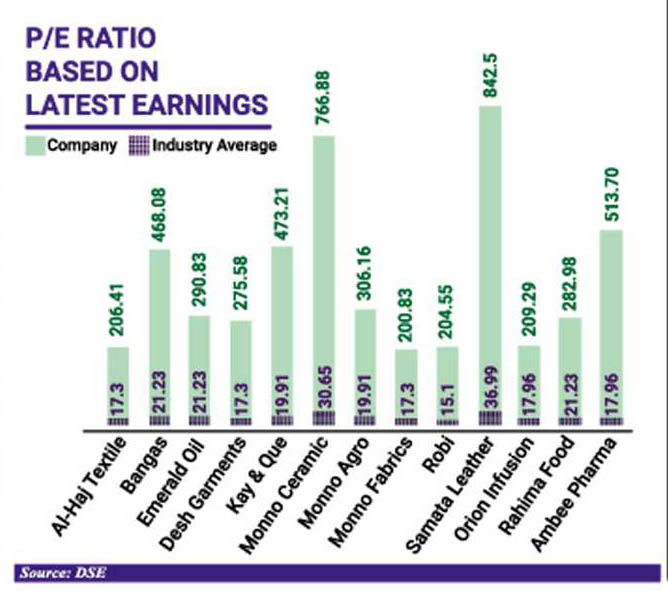
2022's overvalued stocks that defy investment formulae
Mohammad Mufazzal | Sunday, 1 January 2023
Many listed companies have been traded at abnormally high P/E (price to earnings) ratio in the outgoing year when the market has remained persistently gloomy and their peers with good fundamentals have languished at floor prices in absence of buyers.
For example, Samata Leather's P/E ratio stands at 842.5, calculated on the basis of the company's latest earnings per share, according to the DSE website.
It incurred a loss of Tk 0.06 per share for the fiscal year ended in June. The company's auditor even pointed out inconsistencies in its financial reporting.
Not only is the P/E ratio not supported by the business growth but also it far outstrips the weighted average ratio of the tannery industry -- 36.99 -- that Samata is listed under.
The P/E ratio is calculated by dividing the stock's current market price by the latest earnings per share. It shows how much investors are willing to pay for a stock for every taka income of that particular company.
High P/E ratio could be resulted from a high growth forecast for the company in the years to come. It may also suggest that the stock is overvalued.
At a time when the Dhaka Stock Exchange itself has a P/E ratio of 14.08, the overpriced stocks without any supporting indicators raise suspicion.
On the mindset of investors who bought shares at inflated prices, Managing Director of Midway Securities Md. Ashequr Rahman said that when investors chased stocks,
influenced by speculations, P/E ratios were not taken into consideration.
"The market's P/E ratio now is 14. So, those who invested in a company having a P/E ratio of 200 or above are detached from the market.

"It's very clear that a company having a high P/E ratio is overvalued," Mr Rahman added.
The average P/E ratio varies market to market. The historical range for the S&P500 is 13-15.
A senior official of Brac EPL Stock Brokerage said that the historical average ratio is 13-14 for the companies listed on the prime bourse if company valuations go right.
Companies that have had a strong consistent growth and provided good dividends year after year have P/E ratios hovering around the market's ratio.
Such stocks including Square Pharmaceuticals, Grameenphone, Renata, and British American Tobacco Bangladesh have P/E ratios ranging from 8.46 to 26.20.
Of the securities showing abnormal P/E ratios, the EPS of Desh Garments declined 50 per cent year-on-year to Tk 0.13 for the quarter ended in September.
During the same period, its peer Square Textiles' earnings per share dropped 17 per cent to Tk 1.91.
Based on the latest figures, Desh garments' P/E ratio is 275.58 while Square Textiles' 8.84.
Similarly, the P/E ratio of Monno Ceramic Industries stands at 766.88 based on its latest financial data. On the other hand, RAK Ceramics P/E ratio is 24.94.
The EPS of the latter fell 37 per cent year-on-year to Tk 0.29 for the quarter through September whereas the former's declined 81 per cent for the same period.
The P/E ratio shows what the market is willing to pay today for a stock weighing its past or future earnings.
Md. Moniruzzaman, managing director of IDLC Investments, said that if the P/E ratio of a company was 10, it was assumed that the payback period of an investment would be 10 years.
A company can also be traded at a higher P/E ratio for its bright future prospects, established brand image, and reliable business model, he said, adding that "Amazon was traded at a P/E ratio of 700 because of its reliable business model and investors' forecasts."
However, without the relevant growth factors an abnormal hike in P/E ratio does not offer any explanation.
Peter Lynch, author of a book titled 'One Up On Wall Street', said, "The P/E ratio of any company that's fairly priced will equal its growth rate.
"If the P/E ratio of Coca-Cola is 15, you would expect the company to be growing at 15 per cent a year…. But if the P/E ratio is less than the growth rate, you may found yourself a bargain".
mufazzal.fe@gmail.com